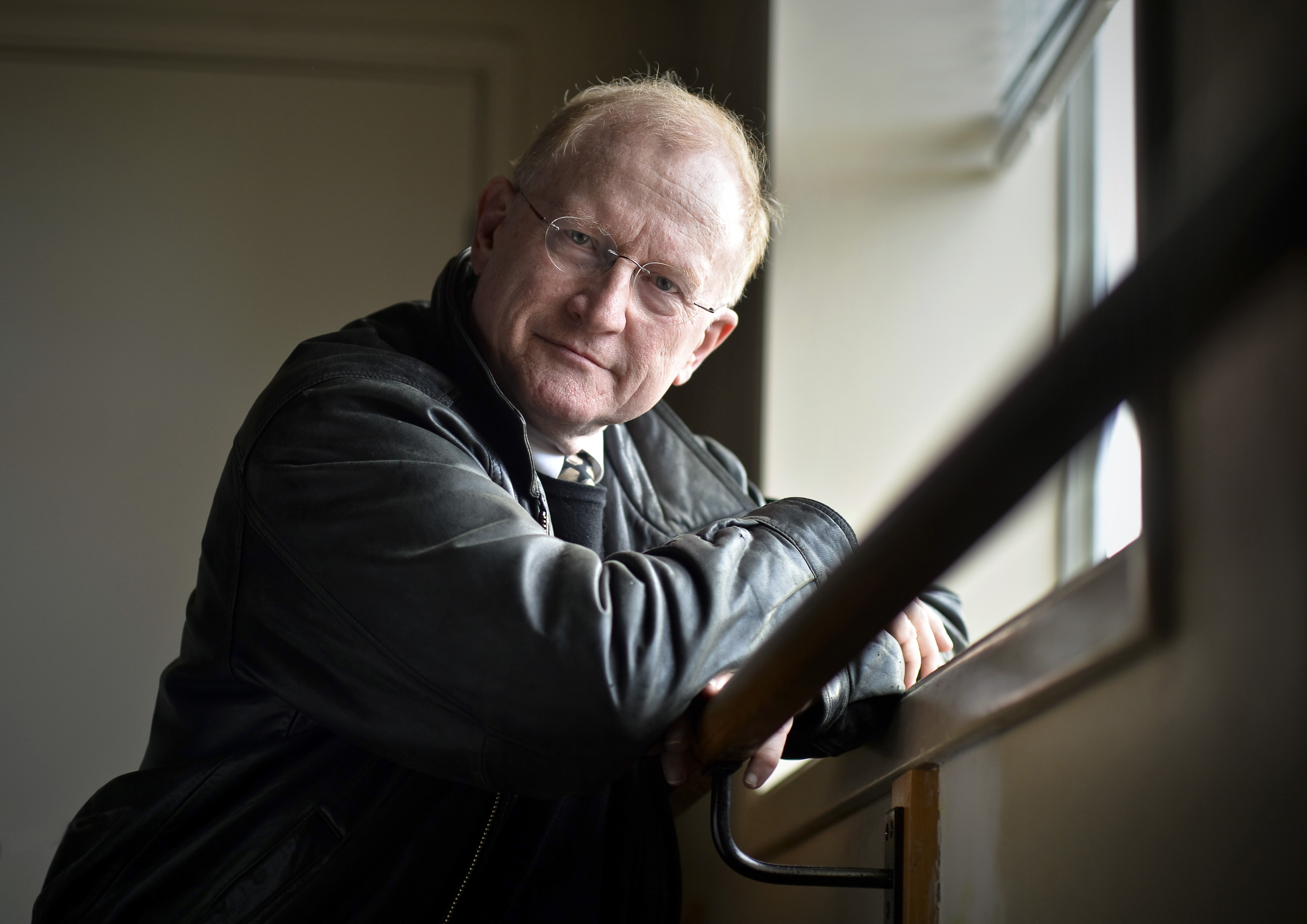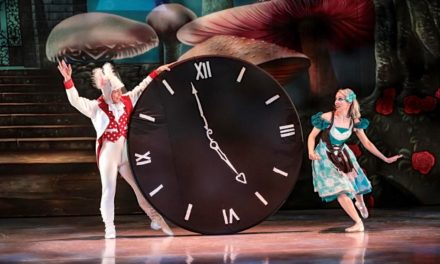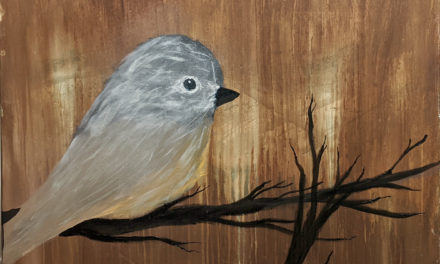(Photo by Paul Carter for TheEugeneReview.com)
By Randi Bjornstad
It may seem like a giant leap from a Junction City farm to the ballet stage, but it turned out to be a grand jeté that Riley Grannan, who retired last summer from a lifelong career in the arts, took in his teens with relative ease.
“I grew up about 7 miles from downtown Eugene, north toward Junction City off River Road,” 69-year-old Grannan said. “We had 5,000 trees — lots of filberts and walnuts — and I did my share of work in the orchards.”
He remembers that those were the days before environmental concerns about chemicals such as pesticides, “when I used to drive the sprayers through the trees — in a complete cloud of spray — without respirators or anything.”
He also remembers his mother’s combination of pride and cynicism about making a living on the land.
“One day she had the newspaper open to the international weather report, and she pointed her finger to Turkey and told me to pray for pestilence,” Grannan said with a bit of a grimace. “She wanted their crops to fail, because they were the other major filbert-growing area besides here. I told her, ‘Mom, that sounds rather uncharitable.’ ”
That was largely because she knew how difficult a living farming was, he said.
“Once, she said to me, ‘Son, I suspect you might have an interest in agriculture. Don’t do it.’ ”

A clipping from Riley Grannan’s scrapbook shows him in a 1981 production of “Pinocchio” with ballerina Susan Zadoff
From the moment Grannan saw a live ballet performance, at Mac Court on the University of Oregon campus, however, all thoughts of tilling the soil disappeared from his future.
“It was an American Ballet Theater production, and a friend of mine knew someone in the cast,” he recalled. “At intermission, we met her friend — he was wearing a gorgeous costume and was beautifully made up — and he was my size, which is rather small. And I thought to myself, ‘I could do that, too. But how?’ ”
After that experience, which Grannan calls “epiphanal,” he stopped by Doreen Gilday’s Eugene School of Ballet, where he was told he was getting a late start, but he signed anyway up and quickly began to make up for lost time.
He continued his performing arts education at the United States International University in San Diego, then spent some time in Montreal.
When he felt he was ready, he bought a one-way ticket to England — in 1967 that cost just $125 — where he learned that there was a lot of work to be had for dancers, but getting a work visa was a serious obstacle for non-British citizens.
“People told me I should go to Germany, where that wouldn’t be a problem, so I went to Frankfurt, and from there to northern Germany,” he said. “I remember looking out the window and seeing the gray sky meet the gray ground and thinking there was this god telling me, ‘You’re going to suffer for this,’ but it turned out to be the right thing to do.”
Grannan describes his approach to life as “willing to pounce, but not to self-destruct.”
Dancing in Germany was hard work, “but there was much more available there for male dancers, and I was getting good roles instead of being in the fifth row of the San Francisco Ballet,” he said.
Even so, he got the feeling his mother wasn’t all that impressed.
“My dad had died when I was 13, so my mom ran the family,” he said. “I think she was supportive of my choice, but she certainly didn’t consider it a highly successful career like my cousins’, who included two lawyers and a doctor.”
He spent a year in Oldenburg, Germany, then moved on to Kiel on the Baltic coast before relocating to Bonn, West Germany’s capital.
“It was interesting there, because they had this cultural thing of working in the morning and then taking a quiet time from 1 p.m. to about 3 p.m.,” Grannan said. “So my landlady and a friend of hers gave me lessons in language and German manners during that time, and I found out wonderful things about them.
“They had been friends since they were little children, and they always had cream cakes. When World War II came, these two women promised each other they would always have cream cakes, and they did.”
Some German habits were counterintuitive to the young American dancer, for example the order in which people went through doorways.
“In the United States, to be polite you open the door for others to walk in, but in Germany, you open the door and walk in first, to protect the people behind you from danger,” he said.
While in Kiel, he met a young English ballet dancer and choreographer named Toni Pimble, and they soon became a couple. They married in 1978 and soon left Europe to return to Grannan’s hometown.
The timing was perfect. Doreen Gilday was ready to sell her ballet school, and Grannan and Pimble became its new owners.
Hard way to make a living
Unlike Europe, where governments at that time were among the greatest patrons of the arts, making a living in the arts in the United States proved to be a challenge, Grannan admits.
“Here you’re told you can do anything if you want to badly enough, but the reality is that you also can go broke at any moment,” he said wryly. “Support for the arts in Europe is highly political, but it is valued.”
During the time he spent there, “Germany alone had 55 publicly supported ballet companies,” Grannan said.
It was a far different situation in the United States in general, and Eugene in particular, but as luck would have it, “Just by chance there was a group of people here who had professional careers,” he said. “So we didn’t have to developed advanced dancers, and we were able to start out performing in schools and places like the WOW Hall.”
That wasn’t enough to make a living, though, so the troupe got involved with an arts-in-education program called Young Audiences of Oregon and started taking their productions all over the state.
“We would leave here at 5:30 in the morning for wherever we were going, do a morning show, two afternoon shows, be back on the road at 2:30 in the afternoon and teach evening classes in Eugene in the evening after we got back,” Grannan recalled. “We would wear the same costumes three times a day, all week long. From 1978 to 1982, we did that, along with performing at schools here.”

Toni Pimble and Riley Grannan met as young dancers in Germany and forged a longtime relationship through marriage and as cofounders of the Eugene Ballet Company. pictured here in their Eugene dance studio in 1985 (Photo by Paul Carter)
Pimble and Grannan’s big professional break came when the Hult Center for the Performing Arts opened in downtown Eugene in September 1982.
“That’s when we started in earnest to develop the Eugene Ballet Company,” he said. “We did ‘Firebird’ — three shows — the day after the Eugene Symphony opened at the Hult Center. We know we had to pounce, we had to go for it on a big scale or not at all.”
Eugene became the smallest city in the country to have a ballet with a $1million budget, “and there were lots of reasons why something like this would not work — and we found them all,” he quipped. “We did some safe things, but also some that were pretty provocative, such as (Igor) Stravinsky’s ‘The Rite of Spring,’ and with a full orchestra.”
He and Pimble had their reservations — the production was far from traditional and also controversial because of its misogynistic treatment of women — “but I finally said, ‘Why not?’ ” he said. “There was a good chance people would never come back to another ballet, but it turned out to be wonderful. It was the right decision.”
The Eugene Ballet Company turned out to be prescient in other ways also, he said, including supporting Toni Pimble in the position of artistic director.
Of 135 ballet companies nationally, and despite the fact that women make up vastly larger percentage than men in the art, there’s still only a handful — Eugene included — with female artistic directors, Grannan said with pride.
Pimble has choreographed more than 60 original ballets during her career, he said.
It was all a lot of hard work.
“We became an organization with a season here in Eugene and also a touring company that did from 30 to 60 shows on the road each year,” he said. “It was necessary, to support the dancers and the costs of production.”
The “real genius of what we did”
The Eugene Ballet Company weathered economic ups and downs that were the death knell of many arts organizations by forging an alliance with arts buffs in Boise, Idaho, “and that was the real genius of what we did,” Grannan said.
“The Morrison Center in Boise was the same size as our facilities here, so we could pretty much do the same productions in both places for minimal extra expense, and that worked wonderfully to help us get through the worst of the economic times,” he said. “Each city had its own future, and we got to hang out with all those people as well as the ones here.”
Their difficult route to success, however, took Grannan and Pimble in different directions mentally and emotionally.
“For 14 years, Toni (Pimble) would work there in Boise, and I would be here working on the budgeting and management,” Grannan said. “We stayed together a long time, but eventually we decided to divorce.”
Even then, their working relationship continued, until his official retirement in 2016.
No regrets
Grannan doesn’t miss his involvement with the performing arts, primarily because of age but also because he accomplished much of what he set out to do.
“I have been in several thousand performances, and that was an energy that I really loved,” he said. “But things change. I can’t do barre work any more, and I’ve had a hip replacement, so it’s out of the question. But my career has been totally fun — I’m not around a lot of people who have done the kind of things I’ve done, the things they always wanted to do.”
In many ways, he believes he came along at the right time for a career in dance.
“I was never one of those really gorgeous people who just automatically got good roles, so I had to get them some other way,” Grannan said. “I didn’t have the ideal body type of a dancer, but I was always theatrical, so I found it easy to relate to audiences, and that helped.”
These days, it probably wouldn’t, he admits, because like many athletic endeavors, there is far more emphasis in dance on what he calls “more Darwinian skill.”
“It’s much harder to succeed now if you’re not born with the ‘right equipment,’ ” Grannan said.
There’s also a tremendous amount of competition that weeds out all but those with the right equipment, he said, recalling a Eugene Ballet Company audition where more than 100 dancers turned out to vie for two spots on the roster.
But he ticks off with satisfaction a few of the roles he was privileged to dance during his decades as a professional ballet dancer: Kaschei in “The Firebird,” the Charlatan in “Petrushka,” the title roles in “Pulcinella” and “Copellia” and Bottom in “A Midsummer Night’s Dream.”
Grannan even danced one of the stepsisters in “Cinderella” and a bluebird in “Sleeping Beauty,” not to mention 10 different roles through the years in various productions of “The Nutcracker.”
He’s also played frequent character roles through the years, including for Eugene Opera productions, but never ones where his singing voice had to carry the day.
“I sing pretty poorly,” he said with a wince, “but I do love the acting.”
That’s probably what drew him to the stage in the first place, Grannan admits.
“Many performers want most to feel the response from the audience to what they’re doing,” he said. “I’ve always just wanted the audience to like what I’m doing for them.”












